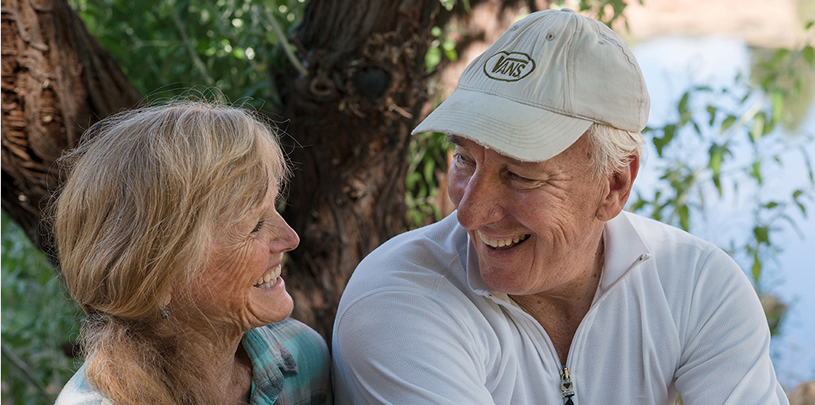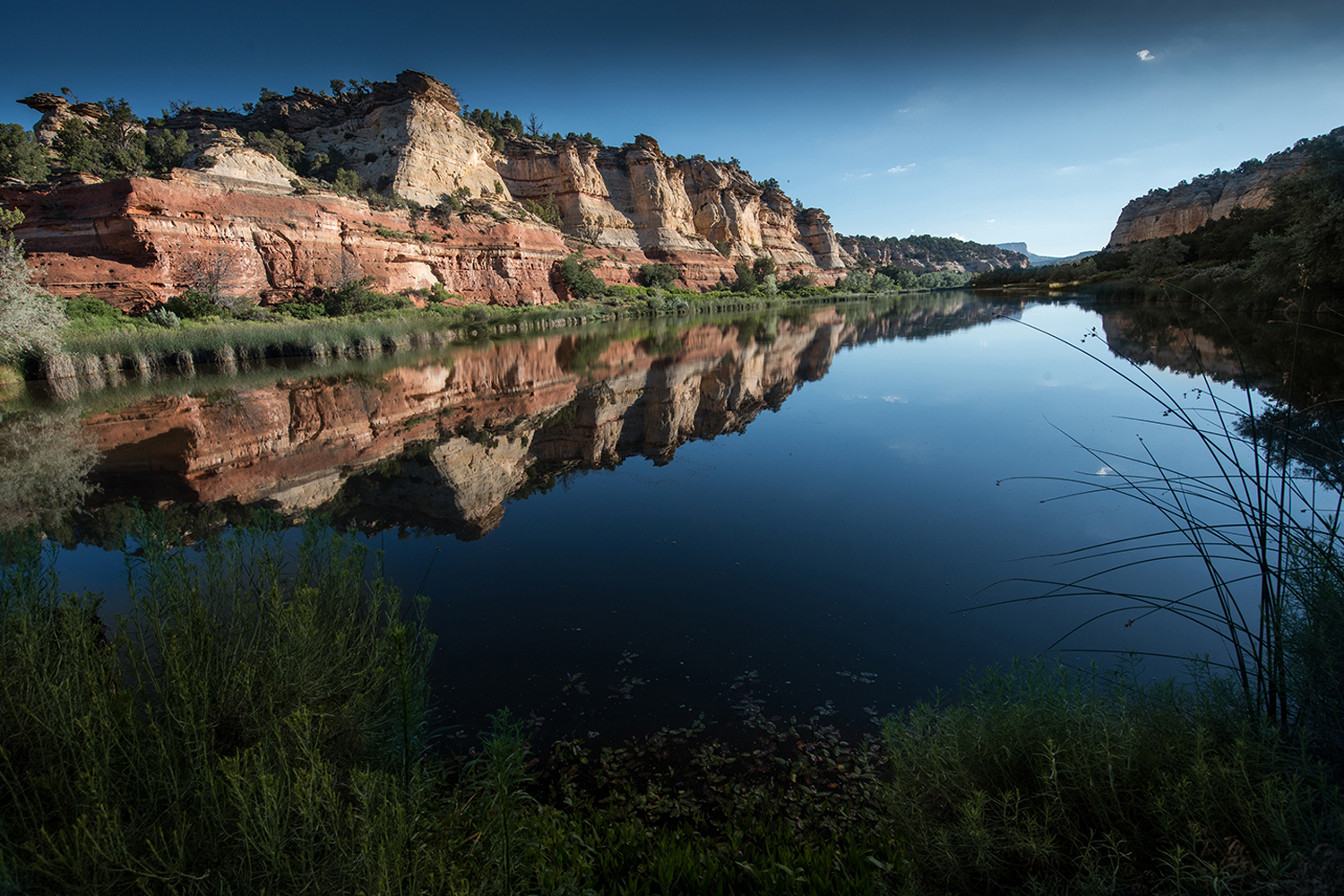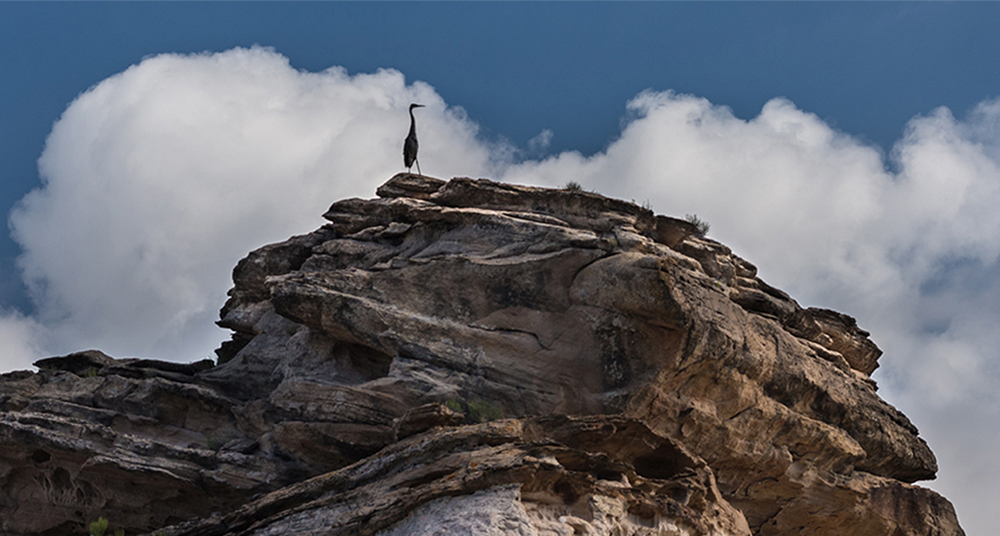
 Guest post by Ellen Morris Bishop, photographer, writer, and geologist
Guest post by Ellen Morris Bishop, photographer, writer, and geologist
A decade ago, Rick and Susie Knezevich (pictured above) were looking for a desert retreat – a change of scenery from their alpine Aspen, Colorado home. They thought that maybe 10 acres or so, close to BLM lands around Kanab, Utah, would be suitable. But, as often happens in life, love changed the plan. Instead of acquiring a compact ten-acre tract, they fell head-over-heels for Johnson Lakes and 840 wild, diverse, and overgrazed acres, an inholding on the southern edge of Grand Staircase-Escalante National Monument.
You’d think that an attorney and an interior decorator, both nearing retirement, would want a place with easy access, paved roads, and the comforts of home. Nope. The trip to Johnson Lakes requires a six-mile ride in a (very) high clearance 4X4 pickup, on a track (they think it’s a road) that crawls up rocky grades and skids through tractionless sandy bottoms. No structures, save relics left by native peoples and early ranchers, mar the landscape. This is a place, Rick noted, for the wild.

It is mind-bogglingly beautiful here. Candy-striped sandstone cliffs frame a long, azure lake. Emerald wetlands – once lakes themselves – floor the valley. Hawks and herons patrol the air. In the fall, migrating deer find an important haven here.
But, transforming overgrazed pastures into a wildlife paradise hasn’t been easy, and it’s still a work in progress. For a decade, Rick and Susie, with one or two part-time employees and volunteer help from Grand Canyon Trust members and others, have pulled weeds and tried to give native plants a chance. The principal concerns include reed canary grass that is invading the wetlands, Scotch thistle that is marching up drier slopes, cheatgrass that infests meadow edges, and Russian olive that chokes the wet bottomland. They avoid using chemicals and large equipment; their work is hands-on, with minimal disturbance.
Susie points out that nature often does its own restoration work faster (and cheaper) than people can. Remove cattle and creek bottoms sprout cottonwood, side-canyons reveal long-dormant native grasses, and biological soil crusts begin to heal. “Some of the best restoration comes from things we haven’t done,” she said. While they have planted some (three) cottonwood trees, the majority of new cottonwoods and native willows sprouted on their own once cattle vanished. These new trees are also encouraged by a raised water table. The Knezevich’s have piled branches and dead sagebrush into incised creek-beds. This natural debris catches sediment, filling the barren, eroded arroyos, and raising groundwater levels in the riparian area.
Dedication, perseverance, and a deep love of place drive this project. When they purchased the land in 2003, they had zero experience with restoration work. They have learned partly from experience and partly from advice – some good (to eradicate invasive thistle, it’s best to dig up the root along with the plant) and some not-so-good (plowing-up an area to uproot cheatgrass generates a bumper-crop of Russian thistle). “We didn’t know anything when we started,” Susie said. “And, we are still learning as we go.”

Despite having two full-time careers in Aspen, the Knezevich’s return to Johnson Lakes several times each year, and with or without help, do the hard, hot work of restoring a native ecosystem. Thistle must be pulled, reed canary grass dug up, and cheatgrass mowed, all before it goes to seed. There are native seeds – Indian rice grass, needle-and-thread, three-awn, squirreltail – to spread, photo points to monitor, and, finally, a quiet and increasingly beautiful place to enjoy. The herons are back. Native pollinators are returning, and native bunchgrasses now out-compete non-natives in the uplands.
“It’s a project that will outlive us,” Rick noted. “But, we are happy that we are starting the process of returning nature to a place where it belongs.”
– Ellen Morris Bishop has helped document the work of the Trust's Utah Forests' Program. She lives in Joseph, Oregon where she is working with Eastern Oregon Legacy Lands – a new natural-history-based educational center.
Watch a short video interview with Rick and Susie produced by Utah Forests intern Marra Clay:
You have the opportunity to comment on how you think some of the most beautiful landscapes in Utah should be managed for the next generation to come.
Read MoreTree ring data helps scientists and land managers protect old-growth pinyon and juniper trees.
Read MorePack your camera and head for the trees! The Colorado Plateau has some of the best displays of fall foliage all season long.
Read More